The BIPOC Art Ecosystem is an explorative response to the barriers that BIPOC artists, makers and movement leaders experience as they pursue their creative and cultural practices through community connections. Our online (and hopefully one day, in-person) space was created so that artists and makers can create, learn and collaborate in a safe and supportive environment. This is a process of inquiry into how we can support each other’s practices, share knowledge, and learn in communities during a global pandemic and the digital age.
Together with Indigenous Brilliance and Part of Studio, the BIPOC Art Ecosystem is facilitating a series of workshops and social media content led by Black and Indigenous artists, makers and movement leaders. The workshops prioritize Black, Indigenous + POC folks, while also inviting the broader community in to learn and support the multiple intersections of anti-racism, anti-oppression, climate change, system change, empowering marginalized youth, advocating for safer spaces for LGBTQIA2s+ folks and so much more.
WHO ARE WE
Lexi Mellish Mingo is a multi-disciplinary artist living and creating on the unceded and unsurrendered territories of the Tsleil-Waututh, Squamish, and Musqueam Nations. Descending from both Afro-Guyanese, English and Scottish ancestry, her work is inspired by the complexity of diasporic experiences, and the process of place making, through community collaboration and dialogue.
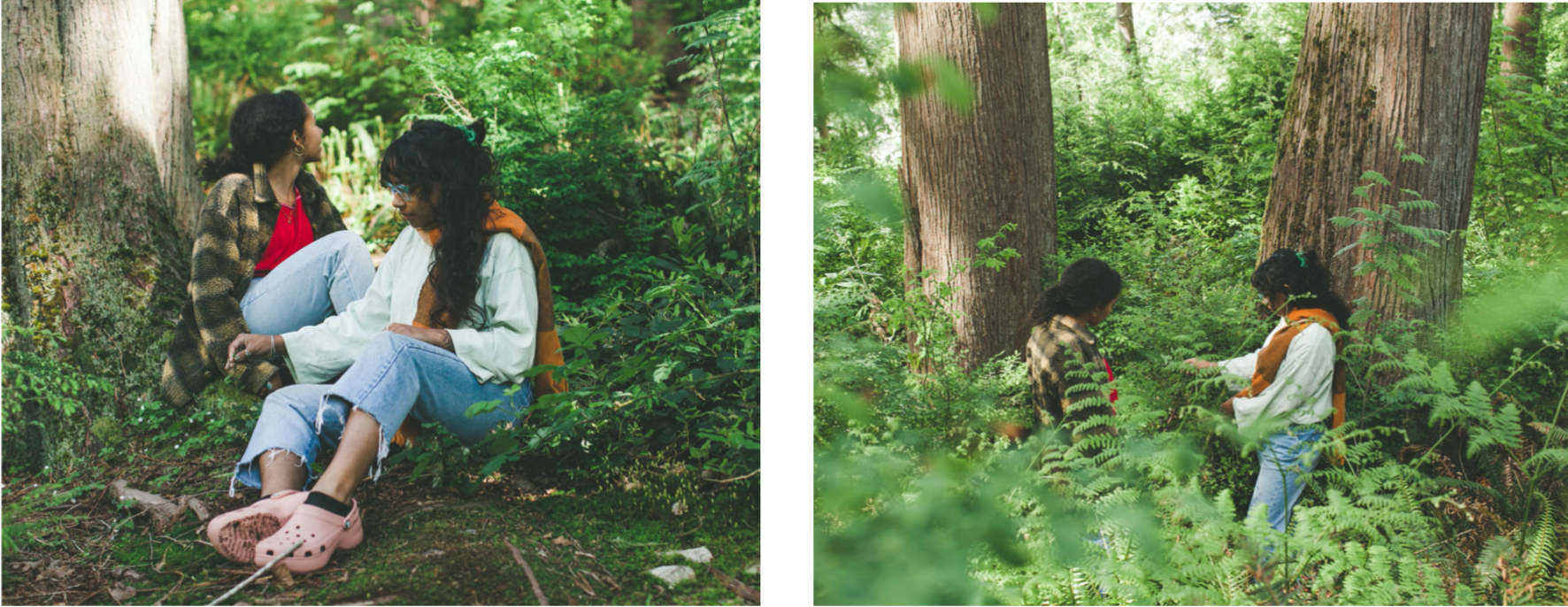
Karmella Cen Benedito De Barros is an inner-city Indigiqueer with Treaty 6 Mistawasis Nêhiyaw and Afro-Brazilian ancestry. They are a Multidisciplinary Artist, Writer and Community Worker born and raised in diaspora as a guest on the unceded Squamish, Tsleil-Waututh and Musqueam territories. Karmella currently works as the Indigenous Brilliance Community Engagement leader. They support the Indigenous Brilliance reading series; a collaborative series between Room Magazine and Massy Books, celebrating Indigenous women/2SQ storytellers.
Karmella’s own artistry is multidisciplinary, grounded in honouring and witnessing the complexity of their environment and communities. Karmella’s most recent work was featured in the Activations Of Solidarity with the Indigenous Curatorial Collective 2021, and Room Magazine issue 44.1. You can find them on instagram @kc.bdb
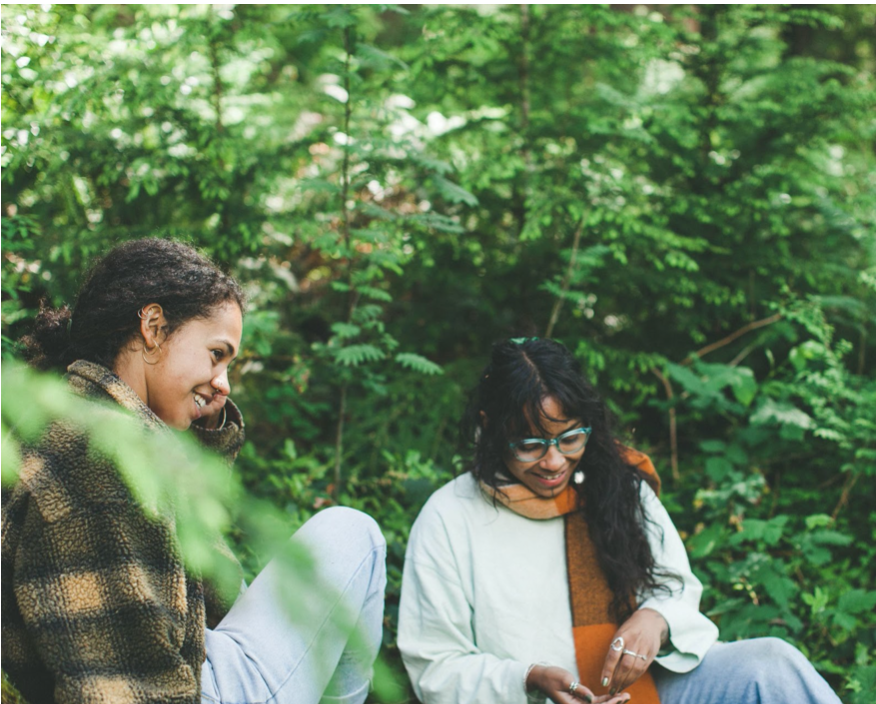
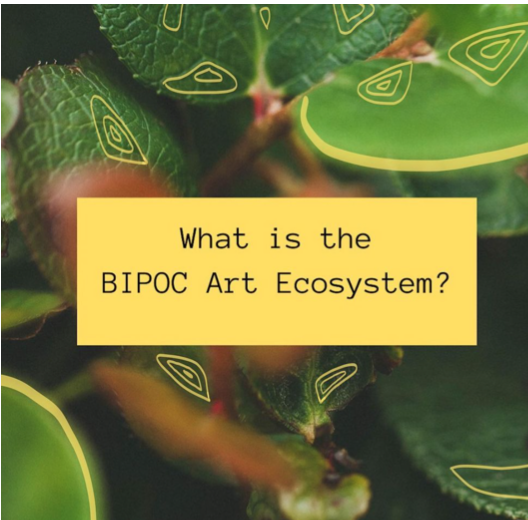
The foundation of this project was inspired by the works of adrienne maree brown (Emergent Strategy + Pleasure Activism) and Tricia Hersey’s Nap Ministry, as well as the many other thought leaders who influenced them.
This project is also inspired by the creative and decolonial work that is currently being done by folks across the Tsleil-Waututh, Musqueam and Squamish territories. Shout out to Black Arts Vancouver, F-O-R-M festival, Takeover Skateboarding, Beads4femmes, Solid State, BC Community Alliance, Nahanee Creative, and so many more groups and individuals in our communities who inspire the work we strive to do. As well, we would like to acknowledge the brilliant work of jaye simpson and VINES Festival’s “Cultivating The Creative”. We continue to learn through our direct communities, as well as the unfolding and transforming process of the BIPOC Art Ecosystem.
WHAT DOES IT MEAN TO CALL THIS PROJECT AN ECOSYSTEM?
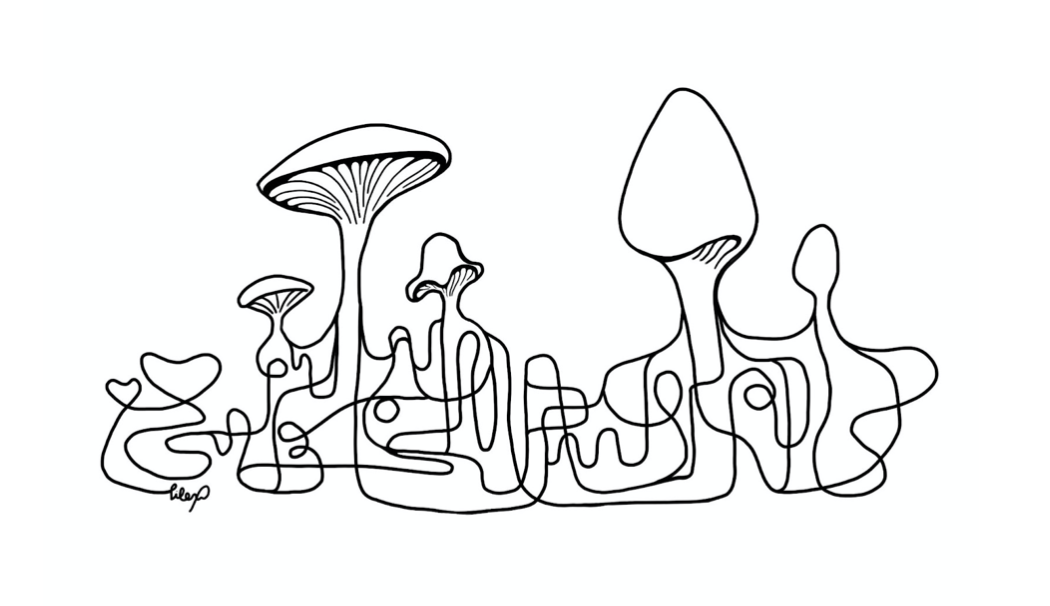 An ecosystem is an interdependent community that honors diversity, symbiotic reciprocity, rest, and growth. This project takes on an ecosystems approach, which is used by biologists to learn about a system through looking at the whole of its interrelational parts. This approach studies the structures, functions, processes and interactions within an environment.
An ecosystem is an interdependent community that honors diversity, symbiotic reciprocity, rest, and growth. This project takes on an ecosystems approach, which is used by biologists to learn about a system through looking at the whole of its interrelational parts. This approach studies the structures, functions, processes and interactions within an environment.
We believe that humans are a part of the ecosystem, despite the impact that many years of colonialism and land-based resource exploitation have had on the environment. Our interpretation of ecosystems approach recognizes system change as a natural and evolutionary process made possible through small-scale, interconnected movement and transformation.
The BIPOC Art ecosystem is a creative environment that is inspired by the structures, functions, processes, and symbiotic relationships found on the land where we live. As well, the ecosystem honours the wisdom and teachings of the host nations on unceded territories to which we (Karmella + Lexi) are uninvited guests. We are a part of centuries of microscopic transformations and changes, and we carry on the work of our ancestors as we centre art and community-building in the continuous fight for liberation, sovereignty, and environmental justice.
At the beginning of this project, we were inspired by the underground network of mushroom mycelium and the way that they support their communities. We started to imagine a creative space that would model mycelium as it’s foundation, hoping that one day, it would grow into an diverse, abundant and sustainable artist ecosystem.
Mycelium, for those who aren’t familiar, is the root system of the mushroom, and the mushroom is the fruit body. The mycelium spans underneath the forest floor, up to thousands of acres in length, absorbing and recycling nutrients along the way.
These mushroom roots (mycelium) feed on dead substances, store carbon and decompose organic matter into absorbable nutrients, which are redistributed into the ecosystem. These webs of mycelium work as a communicative network that mobilizes nutrients to the community members who need it most.
Mycelium are unseen to the eye, but they play a very vital role in the health of the ecosystem. Through our online workshops, social media engagement and virtual creations, we work to strengthen networks of like-minded creatives who imagine a future of collective abundance for their communities.
We walk this path with gratitude and a deep humility, as there have been many Black and Indigenous thought leaders before us, who inform the work that we do. We are not the first, and we will not be the last. Our love feeds the networks that hold us together, nourishing growth from the ground up.
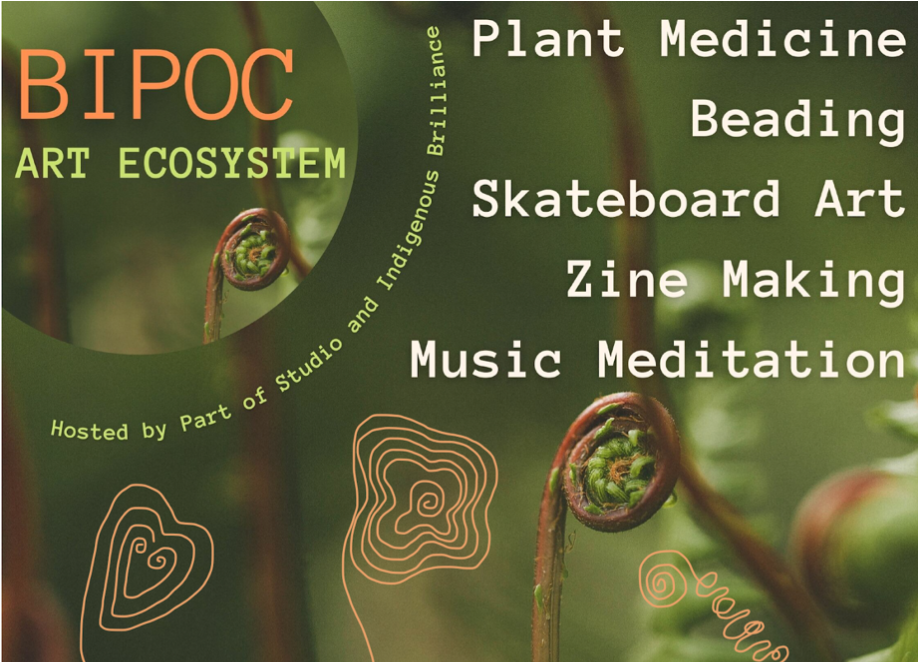
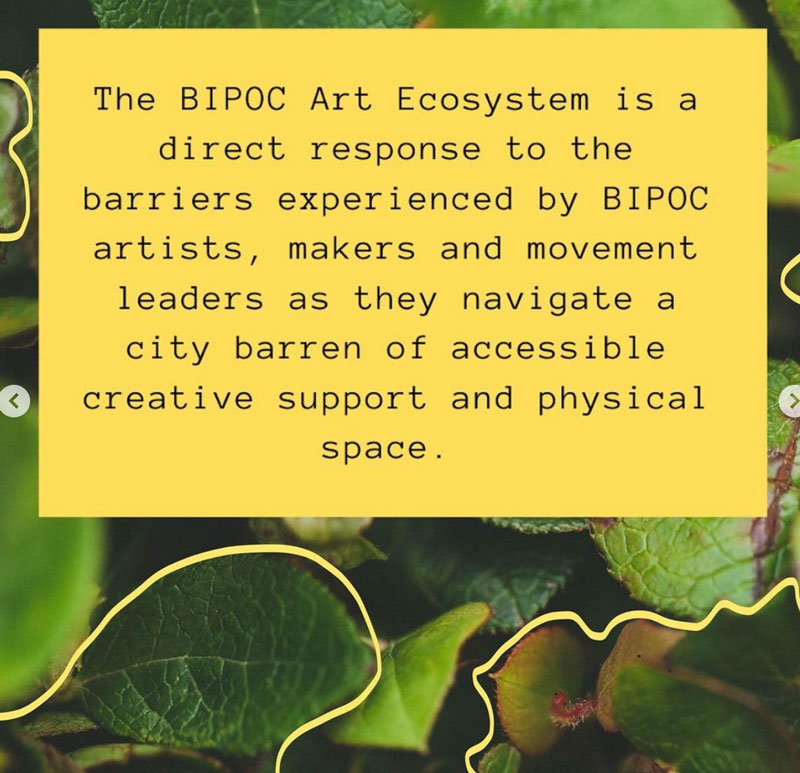
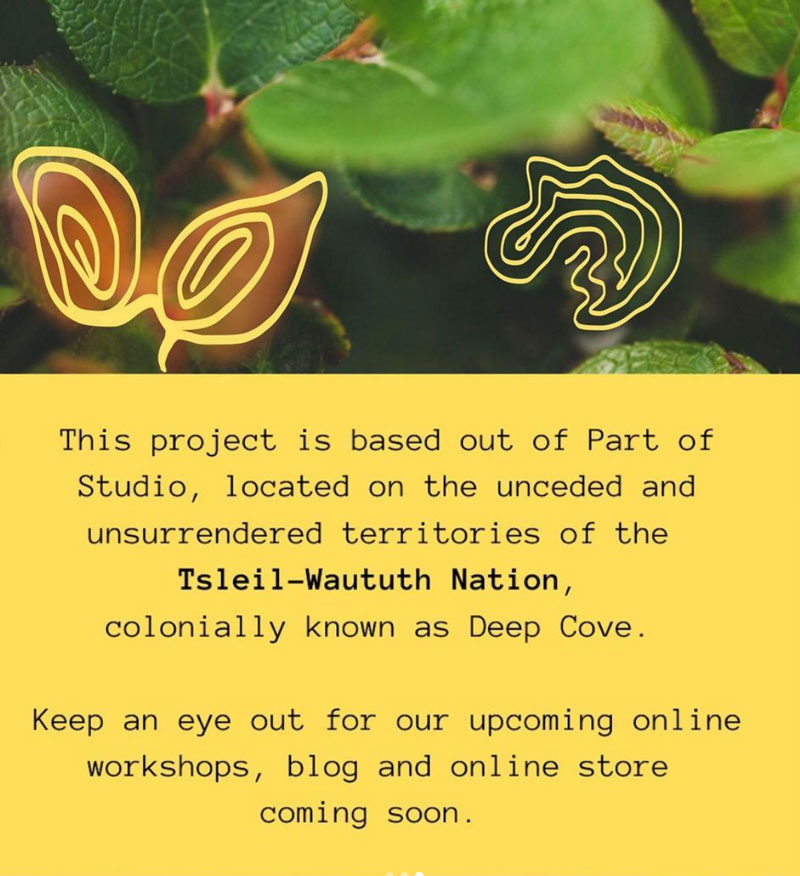
WHAT IS THE PROJECT:
To offer a brief ecosystem timeline: For our first funding period (July 2021 – December 2021), The BIPOC Art Ecosystem has organized a five-part online workshop series, primarily organized and facilitated by Black and Indigenous artists and movement leaders. These workshops have included plant medicine by Hailey Bird Matheson and Alisha Lettman, Beading with Peyton Straker of Beads 4 Femmes, Skateboard grip tape painting with Ryme and Taylor of Takeover Skateboarding, Songwriting with Hadas aka hoodiebrowns, and Music + Meditation with Desire Dawson.
As we move into the new year, we hope to continue offering online and in-person opportunities for Black and Indigenous creatives and leaders to share their knowledge through community workshops, reading groups, online art nights, and more! If you are interested in the work we are doing, follow the project at @bipocartecosystem on instagram to keep updated on events.
REDISTRIBUTION (MYCELIUM/ECOSYSTEM) HOW DOES THE PROJECT CONNECT TO ROOM MAGAZINE, INDIGENOUS BRILLIANCE AND PART OF:
Establishing and maintaining a healthy ecosystem is a very important part of the work that we explore. When we refer to ourselves and our work as an ecosystem, we are speaking to the ways in which our project (The BIPOC Art Ecosystem) intersects with, and is supported by many other collectives, organizations, projects, individuals and communities. Our ecosystem brings together many creatives and organizations which all share the foundational values of uplifting and supporting BI+POC creatives in artistic autonomy, creative liberation, and community care through teaching and learning together.
Room Magazine, Indigenous Brilliance and Part Of are three primary organizations that currently collaborate to fund and support the BIPOC Art Ecosystem through grants and employment opportunities. As the Indigenous Brilliance Community Engagement Leaders, Karmella and Lexi run the BIPOC Art Ecosystem as a project in collaboration with Room and Indigenous Brilliance, with support and guidance from Part Of. This means that the core values and mission for all of these projects and organizations are shared, and that we support each other across our work. The success of one contributes to the success of our collective.
As well, each individual that makes up the BIPOC Art Ecosystem, from the workshop facilitators, to the hosts, the supporters and funders, we all offer something integral to the health and success of the BIPOC Art Ecosystem. We are grateful for each individual who supports the ecosystem’s maintenance, and look forward to growing and sustaining it through continued collaboration and community building.
The BIPOC Art Ecosystem would not exist in its current form without the support of Room Magazine, Indigenous Brilliance, Part Of Studio, and all of our wonderful workshop facilitators. We receive this support and collaborate with gratitude, and also acknowledge the offerings we bring to the community and to our partnering organizations. The BIPOC Art Ecosystem offers community engagement, Black and Indignenous representation and inclusion, as well as a community care, trauma-informed practice, increased cultural safety, a growing ecosystems approach and important perspective to Room magazine and the Indigenous Brilliance Collective. This is all done while creating opportunities for Black, Indigenous and POC creatives to share their knowledge and skills with community, online in as safe a space as possible.
We are grateful for the opportunity to contribute to our ecosystem in the ways that we do, and hope this is a small but helpful model of the ecosystem’s approach in action.
CORE VALUES:
As a collective, community and project branching off from Room Magazine, Indigenous Brilliance and Part Of, the BIPOC Art Ecosystem has multiple core values which ground our work and drive us forward in a good way. The following are the BIPOC Art Ecosystem Core Values which we aim to incorporate across the work we do.
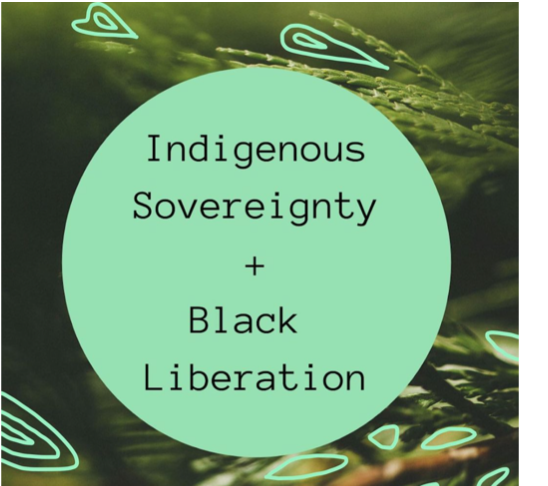
- Facilitate a BIPOC Art Ecosystem and host culturally grounded, accessible workshops by Black and Indigenous artists for the broader community (unless it is culturally sensitive, in that case workshops will be open to specific people).
- Centering and celebrating those who identify as LGBTQ2S+.
- Encouraging intersectional knowledge sharing and allyship with the broader community.
- Build and maintain a mycelium network of community care and redistribution.
- Ongoing social media / blog engagement → Offer a platform to learn and appreciate the nuances of Black and Indigenous culture, creativity and wellbeing.
- Accessibility for BIPOC Queers and Youth → prioritizing 10-20 spots for each workshop with sponsored supply kits to BIPOC LGBTQ2S+ Youth who express interest on a first come first serve basis)
- Connecting community during a global pandemic → hosting workshops online and offering a recording for those who couldn’t make it.
- Create engaging dialogue regarding anti-Black and anti-Indigenous racism.
- Address anti-Black and anti-Indigenous racism that is prevalent in the broader artist and maker community → through intentional opening and community conversation / open dialogue at the closing of each workshops.
- Address the racism and discrimination that we experience as BIPOC/Queers/Young people in the arts.
- Discuss and challenge the idea of negotiation our wellbeing in order to succeed under capitalism (especially for BIPOC Queer Youth creatives). Moving from surviving to thriving / welcoming in and creating opportunities for our joy
- These workshops will take place in Deep Cove, on unceded territories, bordering the Tsleil-Waututh Nation. The 2016 census shows that Deep Cove is a predominantly white neighbourhood with the visible minorities at 4.62 percent of the total population. This is an offering of intercultural interaction and community building through the leadership of Black and Indigenous Artists and Makers.
- Honour and create spaces of cultural safety and sensitivity.
CULTURAL SAFETY AND SENSITIVITY:
One topic and core value that we have discussed in depth within community, is that of cultural safety and sensitivity. In response to our workshop with Beads 4 Femmes, which was a closed workshop for Indigenous folks only, we have built a deeper understanding and definition for the concept of cultural safety and sensitivity, as well as for its importance within the work we do.
Within our collective, cultural safety and sensitivity is practiced through creating opportunities to pay Black and Indigenous people to share their creative skills and knowledge with the BI+POC community at large. Some workshops and events are offered strictly to Indigenous and/or Black participants. This prioritizes the safety of systematically marginalized facilitators, communities, cultural groups and traditional practices to be celebrated and protected respectfully.
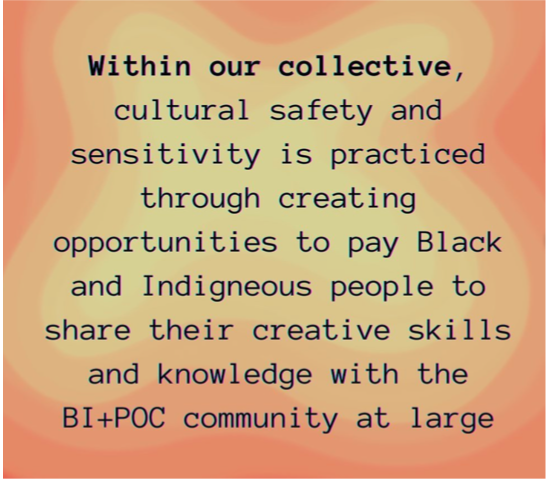
When we say cultural safety or cultural sensitivity, we are acknowledging the responsibility to protect culture, and support folks in accessing their own traditional cultural practices through communal spaces. Cultural safety and sensitivity, for us, works as a framework to prioritize accessibility to traditional cultural practices for people who have been displaced or detached from their culture, communities and traditions. As a Black and Indigenous lead collective, the BIPOC Art Ecosystem commits to prioritizing Black and Indigenous people in the creative, community-building work that we do. Cultural safety and sensitivity is a foundational component when creating sustainable communities of care.
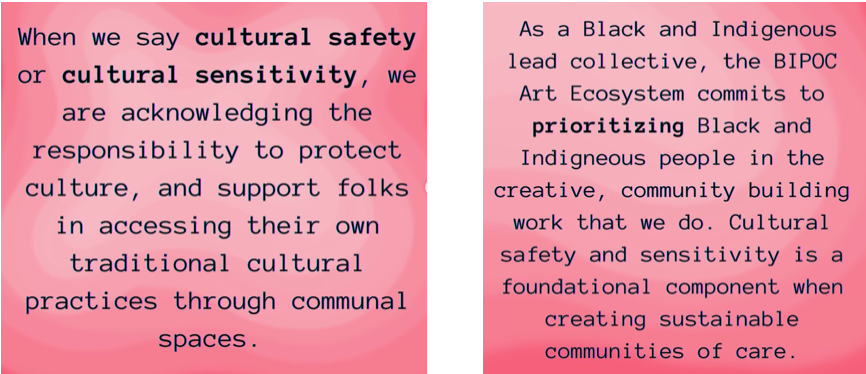
Cultural safety and sensitivity looks different depending on each situation, individual, community etc. Notably, we aim to create “safe enough” spaces that are open to meeting diverse, dynamic, and sometimes contradictory needs. This work is complicated, but we ground ourselves with good intentions. It is important that we protect these cultural practices and spaces, and that we hold them as sacred. In doing so, we honour traditional teaching, prioritize cultural connections for Black and Indigenous people, and protect cultural practices from appropriation.
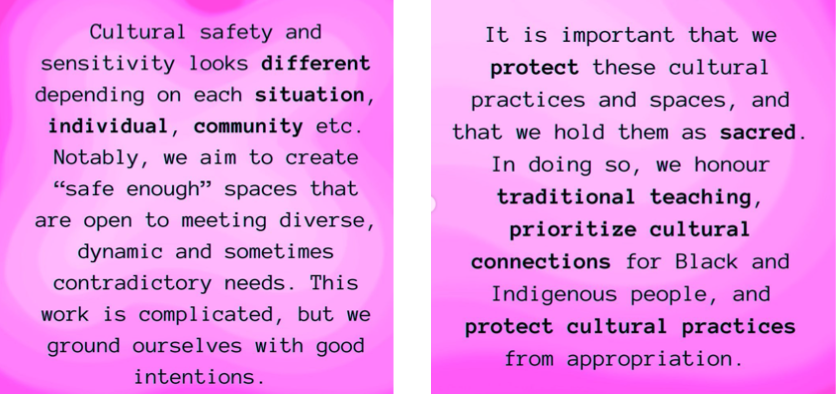
WHAT IS THE FUTURE OF THE PROJECT:
We hope to expand the Art Ecosystem further throughout 2022 and beyond by building cyber community engagement on the BIPOC Art Ecosystem Instagram and the Room magazine Website. As well, we will be hosting more online workshops and community gatherings, both online and in person. Keep up to date with us @bipocartecosystem and check out our resources on our linktree to participate in wealth redistribution to community members or our project.
Photos by Part Of Studio & Graphics by Lexi Mellish Mingo













